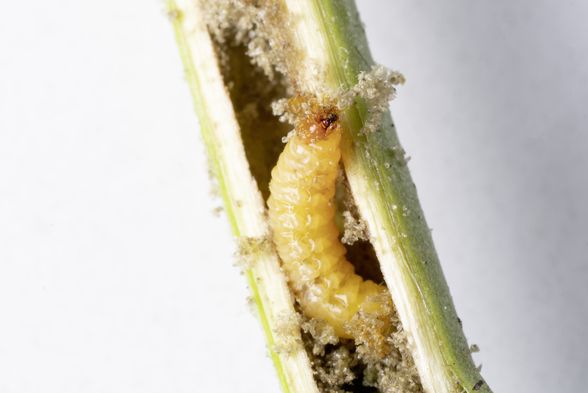In a crosstalk with other plant hormones, these novel plant hormones regulate the resistance to endophytic Trichobaris mucorea larvae
A team of researchers at the Max Planck Institute for Chemical Ecology in Jena, Germany, has discovered that strigolactones, a class of novel plant hormones, mediate the fine-tuning of the production plant defensive substances in the stem of plants of the wild tobacco species Nicotiana attenuata. In a cooperative project with partners in China and Korea, they found that strigolactones and their crosstalk with other hormones involved in plant defense were crucial for tobacco plants’ ability to tolerate insects that live inside the stem. Plants that are no longer able to produce strigolactones also have altered concentrations of jasmontates and auxins and consequently a reduced resistance against the stem-boring larvae of the weevil Trichobaris mucorea.
Not only animals, but also plants have different hormones that control various processes in the body. One class of these signaling substances that were only recognized as hormones quite recently are strigolactones. In plants, they are involved in shoot formation inhibit further branching of the stem. As scientists at the Max Planck Institute for Chemical Ecology have now discovered, a change in the signaling pathway of strigolactones influences processes regulated by other plant hormones, and – as a consequence – a plant’s defense against herbivores.
Observations from the field and in the glasshouse were the starting point for the investigations. “In the field, we noticed that when the pith-feeding larvae of the weevil Trichobaris mucorea attacked tobacco plants, the stems turn red. In the glasshouse, the stems of transgenic lines impaired in strigolactone biosynthesis and signaling turned red too. Since strigolactones influence branching in plants and the root-shoot junction of a plant is the initial entry place where the weevil larva makes its way into the pith of stem, we wanted to know how these hormones affect weevil resistance in tobacco,” said Ming Wang, one of the study leaders.
The red coloring of the stems is caused by anthocynanins, which may also have a defensive function, but are likely involved in the indirect defense of the plants by sending a visual signal to predators of the herbivores. The increased production of the red pigments as well as higher concentrations of other defensive substances, the phenolamides, is due to the increased activity of another group of important plant hormones: the jasmonates. Genetically modified plants that were unable to produce strigolactones, as well as metabolic analyses – i.e. the measurement of the activity of individual metabolic pathways – should now provide information about the role and interaction of the hormones with regard to the resistance to the weevil.
Decreased resistance to stem-boring weevil larvae despite increased jasmonate concentrations
Particularly surprising, however, was the significantly increased concentration of jasmonates in plants in which the strigolactone signaling pathway had been silenced.
“The higher levels of jasmonates in the mutants as well as the increased synthesis of the red anthocyanin pigments should have indicated a stronger defense against herbivores. However, plants lacking strigolactones were significantly more susceptible to Trichobaris mucorea attack. Given the commonly-held knowledge that plant defenses are positively regulated by jasmonate signaling, this apparent disconnect was particularly intriguing,” first author Suhua Li summarizes important results of the study.
Strigolactone-impaired mutants showed a number of metabolic changes: Apart from an over-accumulation of anthocyanins and phenolamides, the absence of strigolactones also affected the production of nicotine, another important defense substance in tobacco. This work breaks new ground by showing how strigolactone interacts with jasmonate and auxin signaling to provide the particular changes in plant metabolites. The special mixture of these metabolites determine – like a cocktail drug therapy developed against diseases – resistance against the attacking herbivore. The work also provides a higher resolution answer to how strigolactone signaling interacts with particularly variable elements of jasmonate signaling: the JAZ proteins, repressors of the jasmonate signaling pathway.
Studies of plant-insect interactions have so far mainly focused free-living folivores. The weevil Trichobaris mucorea, however, lives “endophytically”, i.e. it spends most of its four-month life cycle – the entire larval stage, pupation and the early adult stage before mating – inside the stem of an annual tobacco plant where it feeds on the pith. Apart from the red coloring of the stem, there are hardly any visible signs of an attack by this herbivore from the outside. All you may see is an exit hole in the stem it leaves behind after abandoning its nursery in the already withering plant. However, the relatively long life inside the plant means that the plant has to tolerate this enemy rather than defend itself like against a leaf-feeding insect, which it could fend off with defensive substances.
Defense versus tolerance
The results of the study demonstrate that although strigolactones do not directly regulate defenses against the weevil, they indirectly use the existing hormonal regulatory networks, here via jasmonates and auxins, to produce defensive substances that enable the plant to tolerate this herbivore inside its stem.
“In short, “defenses” damage the herbivores, while “tolerance” traits decrease the damage that herbivore attack causes. It is in the realm of “tolerance” traits that makes the discovery that these hormones fine-tune plant defense via their crosstalk with other hormones, such as jasmonates and auxins, so exciting,” says Ian Baldwin, director of the Department of Molecular Ecology where the investigations have been carried out.
The researchers propose that strigolactones in the plant represent a kind of switch between defense against and tolerance of herbivores, a hypothesis that – if confirmed – would also offer new interesting approaches for plant breeding.
Read the paper: PLOS Biology
Article source: Max Planck Institute for Chemical Ecology
Image: A larva of the weevil Trichobaris mucorea inside the stem of a Nicotiana attenuata plant. This endophytic herbivore spends most of its life cycle inside the plant stem where it feeds on the pith. Credit: Anna Schroll






